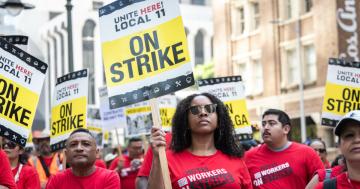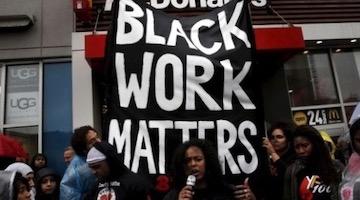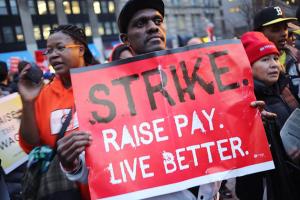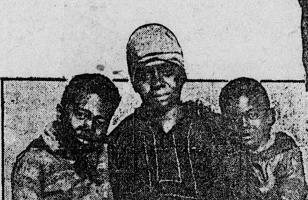The only time the United States has experienced real full employment was during World Wars I and II.
“There has always been much more unemployment in the United States than most people realize.”
American Unemployment: Past, Present, and Future
Frank Stricker
University of Illinois Press
ISBN-13: 978-0252043154
There are some books that all members of the jobs-for-all/right-to-work/full-employment/job-guarantee advocacy movement should have on their bookshelf or in their computer library. Frank Stricker’s new book, “American Unemployment: Past, Present and Future,” is one of those.
Stricker is an historian, and the primary purpose of the book is to provide an account of the nature and extent of the unemployment problem in the United States since the beginning of the industrial era following the end of the Civil War.
The theme of this history is that there has always been a lot more unemployment in the United States than people realize. During economic contractions, the problem is clearly visible, as is its link to business cutbacks and outright failures. But when “good times” return and the economy is “booming,” it’s hard to see unemployment for what it is. Instead, individuals and groups that lack work are much more likely to be blamed for their own joblessness. Stricker’s book provides a powerful retrospective antidote to that assumption.
Explanations of Unemployment
There are three broad explanations of the problem of unemployment that have influenced public policy responses to its victims during the period covered by Stricker’s book.
The first explanation, preferred by conservatives, attributes the problem to the behavior of the unemployed themselves. They are “work shy” and lack the self-discipline required to find and keep a job.
The second explanation attributes the problem to job shortages brought on by economic contractions or slow economic growth. This source of joblessness is commonly referred to as “cyclical” or slow-growth unemployment.
The third explanation attributes the problem to “structural” factors that create mismatches between the kind of workers employers want to hire and the kind of workers comprising the pool of unemployed job seekers. These mismatches can generally be grouped under four headings: skills deficits, the location of available jobs, employment discrimination, and the needs of workers for support services like child care.
Prior to the Great Depression of the 1930s, the behaviorist explanation of unemployment had dominated public policy responses to the problem dating back nearly 600 years in England, to Great Britain’s American colonies, and the United States.
The Great Depression of the 1930s led to a resounding rejection of this behaviorist explanation of unemployment. It was abundantly clear to most people that the mass unemployment of the era was attributable to the economy’s failure to create enough jobs rather than the failure of unemployed workers to seek and accept available employment. And the depression lasted long enough that the job-shortage explanation of unemployment took root and became the mainstream explanation of the problem during economic contractions and the focus of economic policy to combat the problem.
This explanation was supplemented in the 1960s. Due to the influence of the civil rights movement and the discovery of “poverty in the midst of plenty” in books like Michael Harrington’s “The Other America,” the job shortage explanation of “cyclical unemployment” was supplemented by “structuralist” explanations of the problem that focused on barriers to equal employment opportunity that made it difficult for certain individuals and population groups to find work—a mismatch between the skills and experience employers wanted and the skills and experience unemployed individuals possessed; the geographic separation of certain communities from available jobs; employment discrimination; and the unavailability of services like childcare and public transportation that make it impossible for many job wanters to work.
Policy Responses to Unemployment
Since the 1960s, the left-of-center policy response to the problem of unemployment has been dominated by the anti-cyclical and structuralist explanations of the problem. Keynesian and New Keynesian macroeconomic policies have been advocated to address cyclical unemployment while a wide range of policies designed to remove economic, social and cultural barriers to equal employment opportunity have been advocated to address structural unemployment.
The one exception to the left’s more or less exclusive reliance on this strategy occurred in the 1970s when New Deal style direct job-creation was deployed under the Comprehensive Employment and Training Act (CETA) to combat both cyclical and structural unemployment. This model failed to get a full test, though, when a hard-fought campaign to add a job guarantee to CETA faltered as a result of the removal of all mandatory measures designed to achieve full employment from the Humphrey-Hawkins Equal Opportunity and Full Employment Act of 1976 before it was enacted as the Full Employment and Balanced Growth Act of 1978. As for conservatives, they came to accept some reliance on tax-cutting versions of Keynesian macroeconomic policies to combat cyclical unemployment. But they otherwise have strictly adhered to policies based on the behaviorist explanation of unemployment.
The progressive reforms initiated in policy responses to the problem of unemployment from the 1930s through the 1970s marked a significant advance compared to the behavioralist policies pursued before, during and since that the New Deal and civil-rights/anti-poverty eras. Nevertheless, this policy regime has been only partially successful in taming the business cycle and even less successful in combating structural unemployment—the progressive answer to the unemployment that persists across all phases of the business cycle, even when the economy is booming.
The Importance of Stricker’s Book
The importance of Stricker’s book lies in the clarity of its message that the only difference between the problem of unemployment at the top and bottom of the business cycle is that there is less unemployment at the top. Unemployment was the persistently gruesome underbelly of the so-called Gilded Age, reminding us that the designation was coined by Mark Twain to describe the paper-thin gold leaf that covered the greed and corruption of the era. And the same was true of the “Roaring Twenties,” the so-called booming fifties, and, of course, the neo-liberal era. The only time the United States has experienced real full employment was during World Wars I and II.
Stricker’s well documented historical chapters are written in a gentle, easy-to-read style, with ample subheadings to accommodate readers with topical interests. As with all histories, experts may find mistakes in these chapters and quibble over details. I found myself doing that with regard to the New Deal era, which I know best. But the theme of these chapters is well and fully sustained: There has always been much more unemployment in the United States than most people realize.
“The only time the United States has experienced real full employment was during World Wars I and II.”
As noted above, Stricker’s accounts of this unemployment in “good times” are especially enlightening. They drive home the point that the U.S. economy has almost never come close to providing work for everyone who wants it, and the low wages associated with much of the work that is provided is largely caused by the constant surplus of workers compared to available jobs. Moreover, the inadequate protection afforded the unemployed—in the form of either publicly-supported jobs or adequate unemployment benefits—undercuts the security of employed workers as well.
The summary chapters at the end of the book stand on their own because they address general questions. But they also furnish a fitting follow-up to the book’s historical lesson.
The first of these chapters describes the historical origins and controversies associated with efforts to define unemployment and measure its incidence, followed by a critique of the standard count today. Stricker’s emphasis on the extent of the undercount in the headline level and rate of unemployment reported each month by the U.S. Bureau of Labor Statistics is not based on a scientist’s concern to get the number right. It reflects Stricker’s conviction that if the public understood the true dimensions of the unemployment problem in the United States, they would not tolerate our failure to properly address it. He is particularly interested in exposing the blatant falsity of claims that the economy is at or close to full employment when the unemployment rate drops to 4 percent—as most economists claim. He concludes that “[i]f the BLS sticks with current methods, the official rate of unemployment would have to stay at or below 2 percent for a long time to approximate full employment. Since World War II, annual unemployment rates have never been below 2 percent and, in fact, they have almost never been under 4 percent.”
“The low wages associated with much of the work that is provided is largely caused by the constant surplus of workers compared to available jobs.”
The following chapter provides a systematic review of a range of claims regarding the causes of unemployment. The author’s assessment of each of these claims is succinct, and together they provide an excellent set of prompts for discussions of the general question: Why is there so much unemployment across all phases of the business cycle? How much unemployment is attributable to the character traits of the unemployed, the role of skills training, employment discrimination, immigration, globalization, roboticization, wage levels, taxes, income support for the unemployed, and political opposition to policies capable of achieving fuller employment?
My own view is that in assessing these factors it is important to distinguish between their effect on the level of unemployment (how many people are unemployed) and their effect on its distribution among workers (who is unemployed). I think that distinction adds clarity both to our understanding of the problem and to policy debates concerning proposals to combat it.
The book’s final chapter is devoted to policy proposals to achieve real full employment. To be clear about the nature of that goal, Stricker provides a bullet point list of “what real full employment might look like in 2029.” Then, several frequently discussed ideas for promoting more job creation are discussed and dismissed on the ground that they “look good on paper but don’t add many good jobs.” The rest of the chapter is devoted to Stricker’s (and NJFAN’s) preferred option—the use of updated versions of New Deal direct job creation programs to achieve real full employment across all phases of the business cycle. The kind of services and community investments such a program would provide are reviewed, its cost and possible inflationary effects are discussed, and the big question is broached: whether “conservative institutions and ideas doom big federal job programs.” Consistent with the overall style of his book, Stricker’s discussion of this issue is measured but optimistic regarding the possibilities for progressive reform.
In sum, I think this is an eminently usable book. It is full of chapters and subsections of chapters for use in discussion groups and undergraduate classes (for its primary content), graduate and professional school courses (as background reading and to stimulate discussion), and has an abundant source of helpful citations inviting further investigation by scholars (with a full page of notes and citations for each 3 pages of text). And it only costs $18.90 in paperback from the University of Illinois Press, and 9.99 in Kindle format.
This article previously appeared in Jobs for All Newsletter
COMMENTS?
Please join the conversation on Black Agenda Report's Facebook page at http://facebook.com/blackagendareport
Or, you can comment by emailing us at comments@blackagendareport.com



















